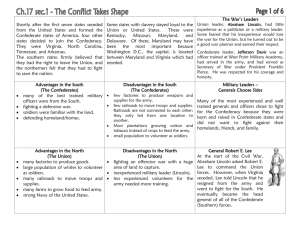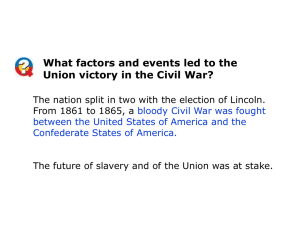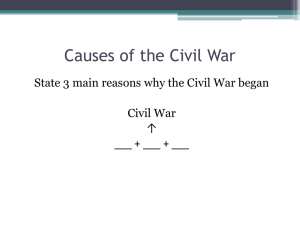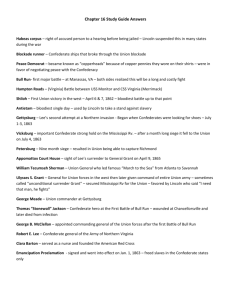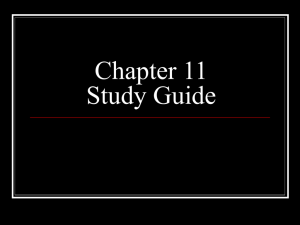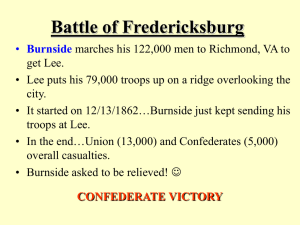The Battles of the Civil War
advertisement
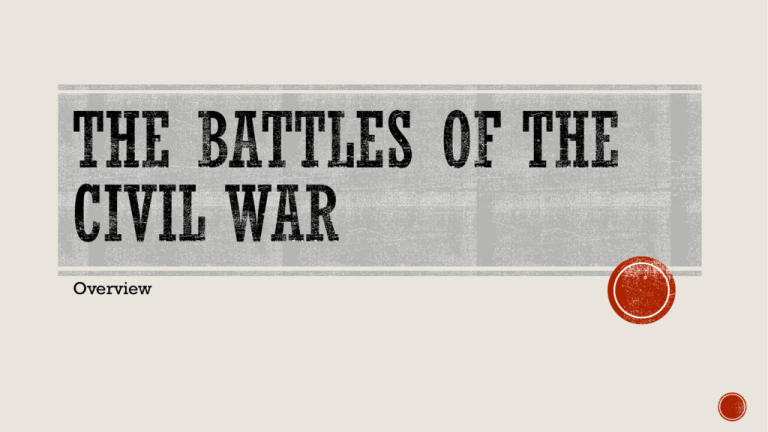
Overview Fort Sumter federal fort located in Charleston Harbor in South Carolina refused to surrender to the Confederates Sixty-eight soldiers in the fort from December 26th, without supply. When Lincoln made the decision to resupply the Fort, the Confederacy decided to assault. In the middle of the night April 11, 1861, an ultimatum; either surrender by 4 A.M. or the Confederate cannons would open fire. At 4:30 A.M. Confederate General P.G.T. Beauregard gave the order to open fire. The next afternoon the fort was surrendered The Civil War had begun. To take Richmond, the Confederate capital, the Union army would first have to defeat the Confederate troops stationed at the town of Manassas, Virginia. July 21, 1861, Union forces commanded by General Irvin McDowell fought with Confederate forces headed by General Pierre Beauregard near a little creek called Bull Run north of Manassas. At one point in the battle, a Confederate officer rallied his troops by pointing his sword toward Southern General Thomas J. Jackson. The officer cried, “There is Jackson standing like a stone wall! Rally behind the Virginians!” From this incident, Jackson won the nickname “Stonewall” Jackson. His men held fast against the Union assault. fresh troops arrived, the Confederates equaled the Union forces in number and launched a countercharge. Attacking the Union line, they let out a blood-curdling scream. This scream, later called the “rebel yell,” caused the Union troops to panic and run The Confederate victory in the First Battle of Bull Run thrilled the South and shocked the North. Many in the South thought the war was won. The North realized it had underestimated its opponent. Lincoln sent the 90-day militias home and called for a real army of 500,000 volunteers for three years. General Robert E. Lee led his army into Maryland, a Union State A gamble to win the war. the first time Lee had attacked a Union state. A Confederate officer accidentally left a copy of Lee’s battle plans wrapped around three cigars at a campsite. When Union troops stopped to rest at the abandoned campsite, a Union soldier stumbled on the plans. The captured plans gave Union General George McClellan a chance to stop Lee and his army. The Union army massed against Lee near the Antietam Creek on September 17, 1862. In a day long battle, 23,582 Americans died, becoming the single bloodiest day in U.S. history. Both sides lost an equal number of men. The Confederate force, which was smaller however, was forced to withdraw. In the aftermath of the Union victory, Lincoln announced the Emancipation Proclamation and also began to allow African American soldiers to fight for the Union. December 11-15, 1862 Over 120,000 Union troops under General Ambrose E. Burnside were met at Fredericksburg, Virginia by a Confederate force of 78,000 under Robert E. Lee. The Union attack failed – resulting in more than 12,500 casualties compared to 5,000 for the Confederates. Remembered as one of the most one-sided battles of the war. Lincoln fired Burnside from his command. The victory restored Confederate morale lost after the defeat in the Battle of Antietam. Just the opposite happened in the Union. This was one of the lowest points of the war for the Union. Vicksburg, Mississippi the last major Confederate strongholds on the Mississippi River. General Ulysses S. Grant began his attack on Vicksburg in May 1863. his direct attacks failed, settled in for a long siege. Grant’s troops surrounded the city - prevented the delivery of food and supplies. the Confederates ran out of food. In desperation, they ate mules, dogs, and even rats. after nearly a month and a half, they surrendered. The Union victory fulfilled a major part of the Anaconda Plan. The North had taken New Orleans the previous spring. with complete control over the Mississippi River, the South was split in two. The Confederates learned of a supply of shoes in the town of Gettysburg, Pennsylvania July 1, 1863, they ran into Union troops. Both sides called for reinforcements, and the Battle of Gettysburg was on The fighting raged for three days. On the rocky hills and fields around Gettysburg, 90,000 Union troops, under the command of General George Meade clashed with 75,000 Confederates. July 3 - The turning point Lee ordered General George Pickett to attack on the middle of the Union line. It was a deadly mistake. Some 13,000 rebel troops charged up the ridge into heavy Union fire. Pickett’s Charge, as this attack came to be known, was torn to pieces. The Confederates retreated and waited for a Union counterattack. But once again, Lincoln’s generals failed to finish off Lee’s army. The furious Lincoln wondered when he would find a general who would defeat Lee once and for all. The toll The North had lost 23,000 men, Over one-third of Lee’s army, 28,000 men, lay dead or wounded. Lee led his army back to Virginia. Many consider this battle to be the turning point of the war. Lee would never invade Northern territory again. General William Tecumseh Sherman’s March to the Sea Followed his successful attempts to take Atlanta Helped Lincoln get reelected. Lincoln and Ulysses S. Grant believed that the Civil War would end only if the Confederacy was broken emotionally and physically. Sherman waged total war a war not only against enemy troops, but against everything that supports the enemy. His troops tore up rail lines destroyed crops burned and looted towns. The results Sherman's March destroyed the Confederacy's ability to carry on the war. Sherman’s name is still cursed in some parts of the South but he is also recognized as a great strategist, a forceful leader, and together with Ulysses Grant – the ablest Union general of the war. June 1864 - Grant’s armies arrived at Petersburg, Virginia, just south of Richmond. Unable to break through the Confederate defenses, the Union forces dug trenches and settled in for a long siege. The two sides faced off for ten months. Lee could not hold out. Grant was drawing a noose around Richmond Lee pulled out, leaving the Confederate capital undefended. The Union army marched into Richmond on April 3, 1865. Lee fled west From Richmond and Petersburg Grant followed in pursuit Lee knew the situation was hopeless. He sent a message to General Grant that he was ready to surrender. April 9, 1865, Lee and Grant met at the Appomattox Court House to arrange the surrender. Grant offered generous terms of surrender. After laying down their arms, the Confederates could return home in peace Taking their private possessions and horses with them. Grant also gave food to the hungry Confederate soldiers. After four long years, the Civil War was over.
